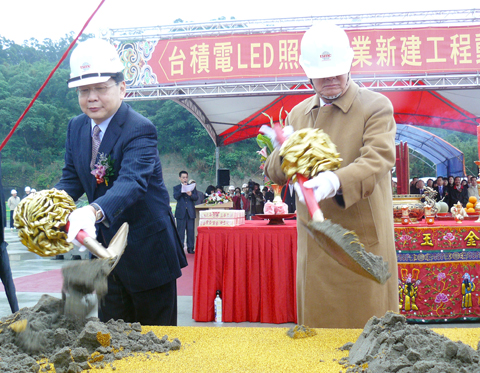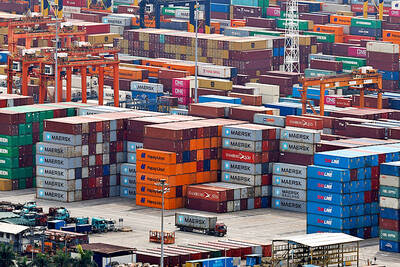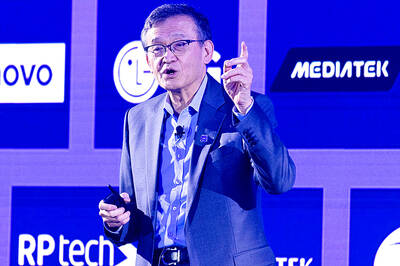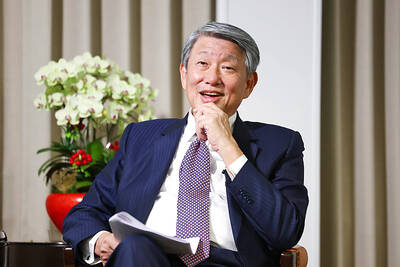Taiwan Semiconductor Manufacturing Co (TSMC, 台積電) yesterday held a groundbreaking ceremony for its first LED research and development center and LED lighting manufacturing plant in Hsinchu, marking the world’s top contract chipmaker’s diversification into the rapidly growing green energy market.
Ten months ago, TSMC unveiled a plan to set up a new business group to explore next growth drivers in clean energy, such as the solar and LED sectors.
In the initial phase, TSMC plans to spend NT$5.5 billion (US$173 million) to build an LED R&D center and a plant in Hsinchu to develop integrated LED technology, process, and packaging and testing. It will begin by offering LED light sources and light engines.

PHOTO: CNA
TSMC also bought a 20 percent stake in the nation’s biggest solar cell maker Motech Industries Inc (茂迪) for about NT$6.23 billion in January.
The chipmaker plans to spend 2 percent of its projected capital spending of US$4.8 billion this year on the new businesses.
Some have questioned the chipmaker’s decision to diversify into the solar and LED sectors amid concern over thinner profit margins compared with the contract chip business.
TSMC chairman Morris Chang (張忠謀) yesterday sought to reassure investors by saying that “the new businesses will be the same [success as its core foundry business] ... Will we enter a business that offers slim profits? No, we won’t.”
Chang said that more than two decades ago, there were also concerns that foundry would be a low-margin business with no future, but now it has become a high profit business with TSMC holding a leading position in the sector.
“I believe the two new businesses will grow swiftly and offer high profit margins,” Chang said.
“The new businesses, I believe, will be a very important [driver] for TSMC five to 10 years from now,” he said.
Last summer, TSMC board appointed former chief executive Rick Tsai (蔡力行) to form a new business unit to explore growth opportunities in green energy sector as overall growth in the semiconductor industry was expected to decelerate in the long term.
The company plans to start equipment installation at the LED factory at the end of the year and start operating next year, Tsai said.
Tsai declined to reveal further details about the new businesses. He only said TSMC would develop its own LED-related technologies and it planned to expand its LED staff to more than 130 people by the end of this year, from about 50 at the moment.
TSMC rival United Microelectronics Corp (聯電) is also moving into the green energy sector. UMC created a business development center and venture capital fund called UMC New Business Investment Corp (聯電新投資事業公司) last August to seek investment opportunities in the solar and LED sectors.

Nvidia Corp CEO Jensen Huang (黃仁勳) today announced that his company has selected "Beitou Shilin" in Taipei for its new Taiwan office, called Nvidia Constellation, putting an end to months of speculation. Industry sources have said that the tech giant has been eyeing the Beitou Shilin Science Park as the site of its new overseas headquarters, and speculated that the new headquarters would be built on two plots of land designated as "T17" and "T18," which span 3.89 hectares in the park. "I think it's time for us to reveal one of the largest products we've ever built," Huang said near the

China yesterday announced anti-dumping duties as high as 74.9 percent on imports of polyoxymethylene (POM) copolymers, a type of engineering plastic, from Taiwan, the US, the EU and Japan. The Chinese Ministry of Commerce’s findings conclude a probe launched in May last year, shortly after the US sharply increased tariffs on Chinese electric vehicles, computer chips and other imports. POM copolymers can partially replace metals such as copper and zinc, and have various applications, including in auto parts, electronics and medical equipment, the Chinese ministry has said. In January, it said initial investigations had determined that dumping was taking place, and implemented preliminary

Intel Corp yesterday reinforced its determination to strengthen its partnerships with Taiwan’s ecosystem partners including original-electronic-manufacturing (OEM) companies such as Hon Hai Precision Industry Co (鴻海精密) and chipmaker United Microelectronics Corp (UMC, 聯電). “Tonight marks a new beginning. We renew our new partnership with Taiwan ecosystem,” Intel new chief executive officer Tan Lip-bu (陳立武) said at a dinner with representatives from the company’s local partners, celebrating the 40th anniversary of the US chip giant’s presence in Taiwan. Tan took the reins at Intel six weeks ago aiming to reform the chipmaker and revive its past glory. This is the first time Tan

CUSTOMERS’ BURDEN: TSMC already has operations in the US and is a foundry, so any tariff increase would mostly affect US customers, not the company, the minister said Taiwanese manufacturers are “not afraid” of US tariffs, but are concerned about being affected more heavily than regional economic competitors Japan and South Korea, Minister of Economic Affairs J.W. Kuo (郭智輝) said. “Taiwan has many advantages that other countries do not have, the most notable of which is its semiconductor ecosystem,” Kuo said. The US “must rely on Taiwan” to boost its microchip manufacturing capacities, Kuo said in an interview ahead of his one-year anniversary in office tomorrow. Taiwan has submitted a position paper under Section 232 of the US Trade Expansion Act to explain the “complementary relationship” between Taiwan and the US